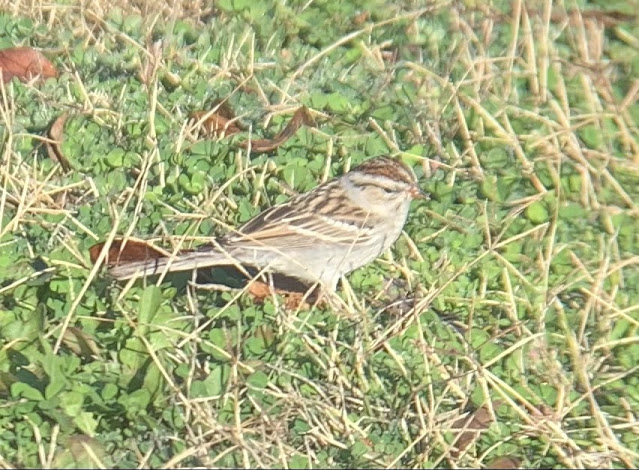Days are lengthening, the COVID vaccine is being distributed/administered, and spring migration will be here before we know it. Things are looking up! My bike-birding has been hampered by other projects, familial commitments, and injured toes (long story) of late, but I've managed to sneak out on the bike a few times since my last post. I'll recap three recent rides in this installment: one in San Mateo County, one in Santa Clara County, and one in San Francisco City/County.
Mountain Bluebird (MOBL) and Red-necked Grebe (RNGR) in San Mateo County
More common towards the Sierras, MOBL makes only rare appearances at/near the coast; there are only a handful of eBird records spread across San Francisco and San Mateo Counties, so folks on the peninsula were surprised by an iNaturalist report from Mori Point Pacifica on January 24. The bird was seen daily for the next week, but I wasn't able to ride for it because of high winds and accompanying rain. Better weather prevailed on the 30th, and I used a free morning to make the hour-long ride to Pacifica. Drama? Nope! The bird showed with 5 minutes of my arrival and bounced around the coastal cliffs exactly as advertised. Pretty sweet San Mateo bird, especially on the bike!
Bay Area Bike Bird #329, San Mateo County Bike Bird #287
The MOBL showing quickly, I shot up to Mussel Rock to look for the Red-necked Grebe(s) which had been hanging around there for the previous week. The species has been a bit of a San Mateo bike nemesis for me. I've tried piggy-backing it onto pursuits of other species, always without success, and this time was no different despite a two-hour vigil. I have it on my SF bike list and my regular San Mateo list from a pelagic, but it's proved elusive in San Mateo when I'm on the bike. Eventually......
Varied Thrush (VATH), Bullock's Oriole (BUOR), and Baltimore Oriole (BAOR) in San Francisco
I was prepared for a longer search since took a friend and I ninety minutes to find a VATH at this location the previous week (by car), so I was stoked when one revealed itself just 5 minutes after I arrived. San Francisco Bike Bird #238 secured with minimal effort, I cruised over to Fort Mason to look for the continuing Bullock's and Baltimore Orioles. I didn't have a whiff of either across three hours, so I packed it in at 12:15. I loaded my crap into my panniers and pushed my bike out of the community garden where I'd stashed it. Mounting up, I heard an unexpected rattle from behind me. Slamming on the brakes and excavating my binocs, I got eyes on the sought Baltimore a moment later. It kept calling, so I fished out my 7D2 and 100-400, reassembled the functional rig, and captured some frames of the improbable bird. As I was pishing it in closer, the Bullock's popped up as well! It was really sweet to salvage both birds after I'd conceded them.
VATH - SF Bike Bird #238 (DSLR)
And what about this thing?!?! It's an immature male Northern Red Bishop which has been hanging around Fort Mason, apparently for some time. He doesn't count towards my various lists since the species is an introduced exotic in California - it's native to equatorial Africa - but I had fun chasing him around community garden while I was looking for the orioles.
That's it for now. Stay safe. I hope to see folks in the field the next few weeks. Cheers!











Hi Dorian,
ReplyDeletei haven't followed you from the beginning, so i'm a bit lost; why doesn't an exotic introduced bird count? seems to me, that however the bird arrived, its here and part of the present flora/fauna. if it had arrived after a huge storm or via some other natural event, would you count that, even though its a newbie to the area? that does happen here and there, and its part of nature, right? how long does a species have to be present before its accepted?
Hi,
ReplyDeleteYes, the distinction it made on how the non-native bird reached it's discovery point. A free running Emu anywhere in North America, for example, is an obvious escapee because the flightless bird could not reach the New World unless transported by humans. The judgement is rarely so straightforward since most birds can fly and are subject to wandering, but we do out best to separate natural vagrancy from human translocation as far as individual birds are concerned. A storm is natural, and whatever birds a storm delivers are 'countable' as far as standardized bird listing practices are concerned. That's the story for vagrancy.
However, things get a bit more complicated because the bishop didn't reach North American as a vagrant; the bird is kept as a cage pet and became established when escaped/released individuals started breeding. The bishop has been breeding in California for years, and -- if it continues to thrive -- it may at some point be an effective part of the native avifauna, like the introduced European Starling or House Sparrow. At that point, the birding authorities -- California Bird Records Committee, American Birding Association, etc -- will deem the species countable. A introduced exotic generally needs to be self-sustaining for 20-30 years before it is deemed countable. It's all very arbitrary and complicated!